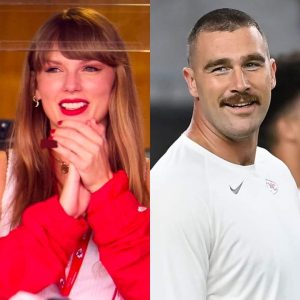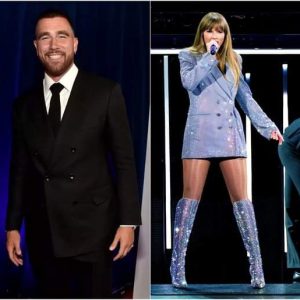taylor’s standing ovation and travis clapping for her. I love that he gives her the same energy she gives him at his games. like that’s so cute
When my family gathers around the table for the holidays, we all take turns sharing what we’re grateful for. This year, my list began predictably enough: Health, job, boyfriend, dog.
“Oh,” I added, “and Taylor Swift and Travis Kelce.”
My father scoffed. He couldn’t comprehend why a pop star and a football player meant so much to me.
Though I’d mentioned them (partly) in jest, I found myself attempting to describe what I felt was particularly affecting about their relationship: She was finally with a guy who seemed to appreciate her. He was famous enough that he didn’t seem intimidated by her superstardom. And they were just so pretty and happy and sweet together!!!

Dad sighed.
“Can you pass the sweet potatoes please?”
He would have been far more perplexed — borderline horrified — if I’d revealed how deep my new obsession went. After years of acting like a full-on brat whenever my partner put sports on TV, I was suddenly planted right beside him whenever a Kansas City Chiefs game was on. My friends and I made bets on how soon Taylor and Travis would get engaged.
Worst of all was the video.
Conservatively, I had watched a clip of Taylor and Travis kissing after her concert in Argentina 100 times. Maybe more, because new angles of the Nov. 11 embrace kept dropping on TikTok — each offering a better view than the last of their first public PDA.

If you don’t know what I’m talking about, I’m sorry your life is so miserable. Let me set the scene: Taylor has just played a sold-out show for 85,000 people in Buenos Aires, the first with Travis in tow as her boyfriend. He has spent the entirety of the three-hour concert singing and dancing in the VIP tent next to Taylor’s dad, who is wearing a Chiefs lanyard around his neck. And when she changes her lyrics to make them about him — “karma is a guy on the Chiefs, coming straight home to me” — he puts his hands on his cheeks in adorable disbelief.
The clip captures Taylor leaving the stage in one of her signature bedazzled bodysuits, waving goodbye to her fans. The instant she spots Travis, awaiting her with his hands held politely behind his back, she runs to him. He smiles and shakes his head, like he can’t believe his luck. She throws her arms around his neck and kisses him. Their lips remain locked as they spin around slowly. She whispers something in his ear as he continues to hold her close. Confetti falls. Fans shriek. Then they disappear from view.
I’ve never been a diehard Swiftie. I attended the Eras tour, but I wasn’t moved to tears. I don’t parse her lyrics for Easter eggs or eagerly await the release of each Taylor’s Version album. And prior to Travis, I’d never been all that invested in her romantic life — particularly the Joe Alwyn phase. (Hard pass.) And yet, like seemingly every other pop-culture obsessive the world over, that moment in Argentina turned me into a de facto body-language expert, a consumer of countless TikTok videos and “Today Show” segments, a hopeless romantic, a true believer.
Suddenly, I found myself a not-so-neutral observer in the very sort of story I was trained to cover: how a hitmaking blond and a good-natured tight end managed to capture the attention of a divided nation, increasing NFL ratings, boosting Kelce jersey sales and somehow making Taylor even more ubiquitous than she already was.
What was it about that clip of them kissing that made me — made us — feel so damn good?
“What kind of good? That’s important.”
I’m on the phone with Dr. Helen Fisher, a biological anthropologist and senior research fellow at the Kinsey Institute who has spent her career studying brain imaging to understand how love impacts humans.
My Taylor-and-Travis infatuation felt like the gooey, swelling in your throat kind of good. The suspended in some dreamy place where all of life’s promise is fulfilled kind of good. A feeling, Fisher suspects, that comes from oxytocin, a hormone produced by your brain that gives you a sense of calm, of sweetness.
“It’s the basic neural mechanism of attachment,” she says. Others might have seen that moment in Buenos Aires and experienced a dopamine surge — “a feeling of intense pleasure, energy, motivation and optimism” that is often correlated with the rapture of romantic love.
A pull quote from the story
Even if we voyeurs are not kissing Taylor or Travis ourselves, our bodies can still experience the same chemical reactions just from watching them. Even Fisher, who was unfamiliar with Taylor’s career and viewed the clip for the first time after our call, found herself as moved as I was: “It was totally CHARMING — so real, so human, so unrehearsed and so dramatic,” she emailed later. The phenomenon behind it is called “emotional contagion,” according to Fisher — the reason why we tear up when our friends cry or get hungry when those around us are eating.
Taylor Swift is patient zero for emotional contagion.
When she got her start at 17 years old, she presented the image of a teenage girl who longed for a life just out of her grip: On her eponymous debut album, released in 2006, she sang about crying in her room, writing songs about a boy who liked a girl who “got everything that I have to live without.”





